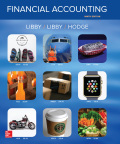
Financial Accounting
9th Edition
ISBN: 9781259738692
Author: Libby
Publisher: MCG
expand_more
expand_more
format_list_bulleted
Textbook Question
Chapter A, Problem 1ME
Matching Measurement and Reporting Methods
Match the following. Answers may be used more than once:
| Measurement Method | |
| A. Amortized cost | — 1. Less than 20 percent ownership. |
| B. Equity method | — 2. Current fair value. |
| C. Acquisition method and consolidation | — 3. More than 50 percent ownership. |
| D. Fair value method | — 4. At least 20 percent but not more than 50 percent ownership. — 5. Bonds held to maturity. — 6. Original cost less any amortization of premium or discount with the purchase. — 7. Original cost plus proportionate part of the income of the affiliate less proportionate part of the dividends declared by the affiliate. |
Expert Solution & Answer
Want to see the full answer?
Check out a sample textbook solution
Students have asked these similar questions
What was the balance in retained Earnings at December 31 2023 ?
A change in accounting estimate affects? A. Prior periods only B. All periods equally C. Current period only D. Current and future periods MCQ
Can you solve this financial accounting problem using accurate calculation methods?
Chapter A Solutions
Financial Accounting
Ch. A - Prob. 1QCh. A - Explain the difference in accounting methods used...Ch. A - Explain how bonds held to maturity are reported on...Ch. A - Explain the application of the cost principle to...Ch. A - Under the fair value method, when and how does the...Ch. A - Under the equity method, why does the investor...Ch. A - Prob. 7QCh. A - Prob. 8QCh. A - Prob. 9QCh. A - Company X owns 40 percent of Company Y and...
Ch. A - Prob. 2MCQCh. A - Dividends received from stock that is reported as...Ch. A - Prob. 4MCQCh. A - Prob. 5MCQCh. A - When using the equity method of accounting, when...Ch. A - Prob. 7MCQCh. A - Prob. 8MCQCh. A - Which of the following is true regarding the...Ch. A - Prob. 10MCQCh. A - Matching Measurement and Reporting Methods Match...Ch. A - Prob. 2MECh. A - Prob. 3MECh. A - Prob. 4MECh. A - Prob. 5MECh. A - Prob. 6MECh. A - Prob. 7MECh. A - Prob. 8MECh. A - Prob. 9MECh. A - Prob. 10MECh. A - Prob. 11MECh. A - Prob. 1ECh. A - Prob. 2ECh. A - Recording Transactions in the Available-for-Sale...Ch. A - Prob. 4ECh. A - Prob. 5ECh. A - Reporting Gains and Losses in the Trading...Ch. A - Prob. 7ECh. A - Prob. 8ECh. A - Prob. 9ECh. A - Prob. 10ECh. A - Prob. 11ECh. A - Prob. 1PCh. A - Prob. 2PCh. A - Prob. 3PCh. A - Prob. 4PCh. A - Prob. 5PCh. A - Comparing Methods to Account for Various Levels of...Ch. A - Prob. 7PCh. A - Recording Investments for Significant Influence LO...Ch. A - Prob. 9PCh. A - Prob. 10PCh. A - Prob. 11PCh. A - Prob. 1APCh. A - Prob. 2APCh. A - Reporting Passive Investments During January 2017,...Ch. A - Prob. 4APCh. A - Prob. 5APCh. A - Prob. 6APCh. A - Prob. 1CONCh. A - Finding Financial Information Refer to the...Ch. A - Prob. 2CPCh. A - Prob. 3CPCh. A - Prob. 4CPCh. A - Prob. 5CPCh. A - Prob. 6CP
Knowledge Booster
Learn more about
Need a deep-dive on the concept behind this application? Look no further. Learn more about this topic, accounting and related others by exploring similar questions and additional content below.Similar questions
- I need guidance with this financial accounting problem using the right financial principles.arrow_forwardPlease explain the solution to this general accounting problem with accurate explanations.arrow_forwardCan you solve this general accounting problem with appropriate steps and explanations?arrow_forward
- Can you explain the correct methodology to solve this financial accounting problem?arrow_forwardPlease provide the solution to this financial accounting question using proper accounting principles.arrow_forwardJK Corporation is finishing its fifth year in business with a gross income of $780,000 and total deductions of $420,000. In the second year, the company had a net loss of $125,000, and in the fourth year, it had a net loss of $95,000. What is JK Corporation's taxable income for this year, assuming Net Operating Losses (NOLs) are carried forward?arrow_forward
- Cedar Fabricators uses a standard costing system. For its main product, the standard material cost is $14.00 per kilogram and the standard quantity allowed is 3 kilograms per unit. During April, the company purchased 15,000 kilograms of material at $13.75 per kilogram and used 14,200 kilograms to produce 4,600 units. Calculate the material price variance and material quantity variance. Give me answerarrow_forwardI am trying to find the accurate solution to this general accounting problem with appropriate explanations.arrow_forwardCoca Industries reported net sales of $7,200,000 for the year. The company's beginning total assets were $3,600,000, and its asset turnover ratio was 2.5 times. Based on this information, what is the ending total asset balance?arrow_forward
arrow_back_ios
SEE MORE QUESTIONS
arrow_forward_ios
Recommended textbooks for you
- Principles of Accounting Volume 1AccountingISBN:9781947172685Author:OpenStaxPublisher:OpenStax College
 Financial Reporting, Financial Statement Analysis...FinanceISBN:9781285190907Author:James M. Wahlen, Stephen P. Baginski, Mark BradshawPublisher:Cengage Learning
Financial Reporting, Financial Statement Analysis...FinanceISBN:9781285190907Author:James M. Wahlen, Stephen P. Baginski, Mark BradshawPublisher:Cengage Learning


Principles of Accounting Volume 1
Accounting
ISBN:9781947172685
Author:OpenStax
Publisher:OpenStax College

Financial Reporting, Financial Statement Analysis...
Finance
ISBN:9781285190907
Author:James M. Wahlen, Stephen P. Baginski, Mark Bradshaw
Publisher:Cengage Learning
Financial instruments products; Author: fi-compass;https://www.youtube.com/watch?v=gvxozM3TUIg;License: Standard Youtube License